2000 BMW 328Ci CONVERTIBLE service
[x] Cancel search: servicePage 149 of 199

149n
IndexDataTechnologyRepairsCar careControlsOverview
OBD interface socket The interface socket for the onboard
diagnostics is located on the driver's
side at the left-hand bottom of the
dashboard and under a cover. The
cover has the letters "OBD" on it.
The purpose of the OBD system is to
ensure proper emission control system
operation for the life of the vehicle by
monitoring emission-related compo-
nents and systems for deterioration and
malfunction.460us250
An illuminated indicator informs
you of the need for service, not
that you need to stop the vehicle.
Your system should be checked by your
BMW center at the earliest possible
opportunity.
If the indicator blinks or flashes, this
indicates a high level of engine misfire.
Reduce speed and contact your near-
est BMW center immediately. Severe
engine misfire over only a short period
of time can seriously damage emission
control components, especially the
catalytic converter.
Warning lamp: "Service Engine
Soon" for Canadian models
When the fuel filler cap is not pro-
perly tightened, the OBD system
can detect the vapor leak and the indi-
cator will light up. If the fuel filler cap is
then tightened, the indicator will usually
go out after a short period of time.<
Page 151 of 199
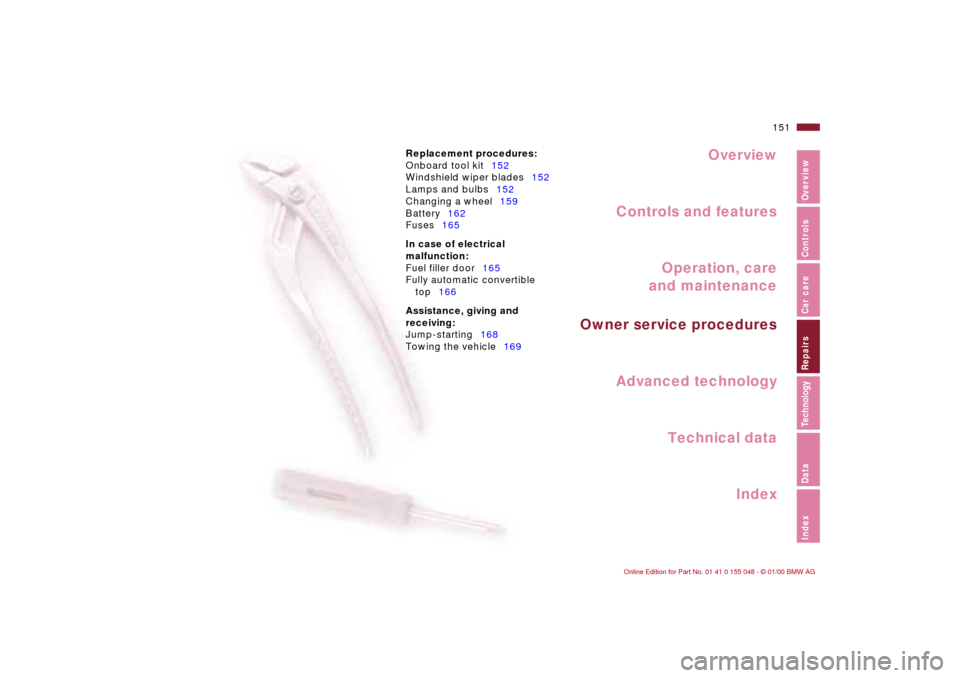
Overview
Controls and features
Operation, care
and maintenance
Owner service procedures
Technical data
Index Advanced technology
151n
IndexDataTechnologyRepairsCar careControlsOverview
Replacement procedures:
Onboard tool kit152
Windshield wiper blades152
Lamps and bulbs152
Changing a wheel159
Battery162
Fuses165
In case of electrical
malfunction:
Fuel filler door165
Fully automatic convertible
top166
Assistance, giving and
receiving:
Jump-starting168
Towing the vehicle169
Repairs
Page 152 of 199
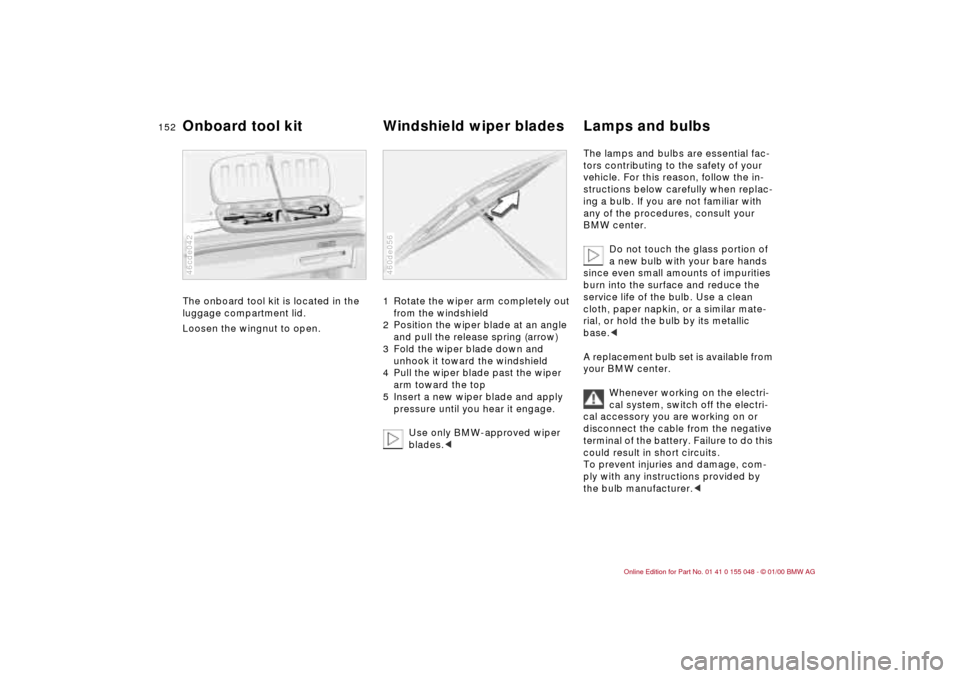
152n
The onboard tool kit is located in the
luggage compartment lid.
Loosen the wingnut to open.
46cde042
1 Rotate the wiper arm completely out
from the windshield
2 Position the wiper blade at an angle
and pull the release spring (arrow)
3 Fold the wiper blade down and
unhook it toward the windshield
4 Pull the wiper blade past the wiper
arm toward the top
5 Insert a new wiper blade and apply
pressure until you hear it engage.
Use only BMW-approved wiper
blades.<460de056
The lamps and bulbs are essential fac-
tors contributing to the safety of your
vehicle. For this reason, follow the in-
structions below carefully when replac-
ing a bulb. If you are not familiar with
any of the procedures, consult your
BMW center.
Do not touch the glass portion of
a new bulb with your bare hands
since even small amounts of impurities
burn into the surface and reduce the
service life of the bulb. Use a clean
cloth, paper napkin, or a similar mate-
rial, or hold the bulb by its metallic
base.<
A replacement bulb set is available from
your BMW center.
Whenever working on the electri-
cal system, switch off the electri-
cal accessory you are working on or
disconnect the cable from the negative
terminal of the battery. Failure to do this
could result in short circuits.
To prevent injuries and damage, com-
ply with any instructions provided by
the bulb manufacturer.<
Onboard tool kit Windshield wiper blades Lamps and bulbs
Page 153 of 199
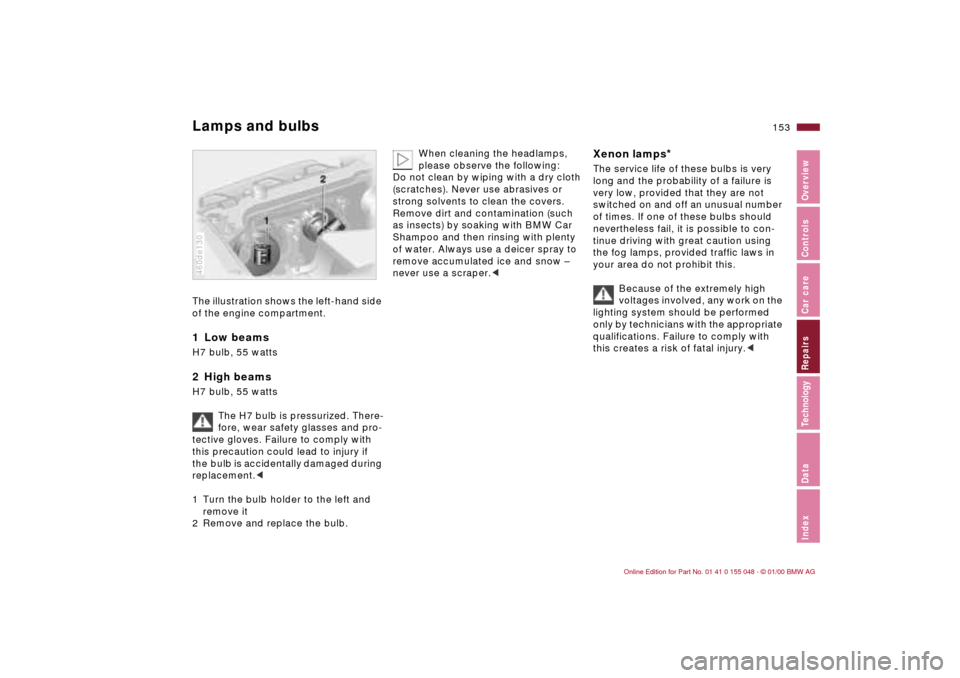
153n
IndexDataTechnologyRepairsCar careControlsOverview
Lamps and bulbsThe illustration shows the left-hand side
of the engine compartment.1 Low beams H7 bulb, 55 watts2 High beamsH7 bulb, 55 watts
The H7 bulb is pressurized. There-
fore, wear safety glasses and pro-
tective gloves. Failure to comply with
this precaution could lead to injury if
the bulb is accidentally damaged during
replacement.<
1 Turn the bulb holder to the left and
remove it
2 Remove and replace the bulb.460de130
When cleaning the headlamps,
please observe the following:
Do not clean by wiping with a dry cloth
(scratches). Never use abrasives or
strong solvents to clean the covers.
Remove dirt and contamination (such
as insects) by soaking with BMW Car
Shampoo and then rinsing with plenty
of water. Always use a deicer spray to
remove accumulated ice and snow –
never use a scraper.<
Xenon lamps
*
The service life of these bulbs is very
long and the probability of a failure is
very low, provided that they are not
switched on and off an unusual number
of times. If one of these bulbs should
nevertheless fail, it is possible to con-
tinue driving with great caution using
the fog lamps, provided traffic laws in
your area do not prohibit this.
Because of the extremely high
voltages involved, any work on the
lighting system should be performed
only by technicians with the appropriate
qualifications. Failure to comply with
this creates a risk of fatal injury.<
Page 162 of 199
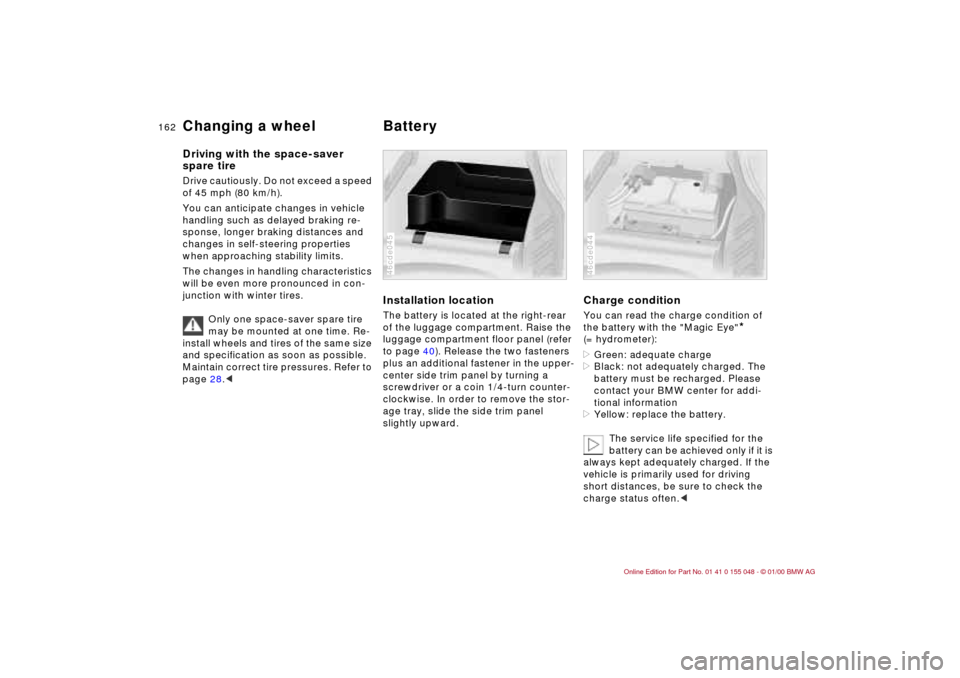
162n
Changing a wheel Battery Driving with the space-saver
spare tireDrive cautiously. Do not exceed a speed
of 45 mph (80 km/h).
You can anticipate changes in vehicle
handling such as delayed braking re-
sponse, longer braking distances and
changes in self-steering properties
when approaching stability limits.
The changes in handling characteristics
will be even more pronounced in con-
junction with winter tires.
Only one space-saver spare tire
may be mounted at one time. Re-
install wheels and tires of the same size
and specification as soon as possible.
Maintain correct tire pressures. Refer to
page 28.<
Installation locationThe battery is located at the right-rear
of the luggage compartment. Raise the
luggage compartment floor panel (refer
to page 40). Release the two fasteners
plus an additional fastener in the upper-
center side trim panel by turning a
screwdriver or a coin 1/4-turn counter-
clockwise. In order to remove the stor-
age tray, slide the side trim panel
slightly upward.46cde045
Charge conditionYou can read the charge condition of
the battery with the "Magic Eye"
*
(= hydrometer):
>Green: adequate charge
>Black: not adequately charged. The
battery must be recharged. Please
contact your BMW center for addi-
tional information
>Yellow: replace the battery.
The service life specified for the
battery can be achieved only if it is
always kept adequately charged. If the
vehicle is primarily used for driving
short distances, be sure to check the
charge status often.<
46cde044
Page 163 of 199
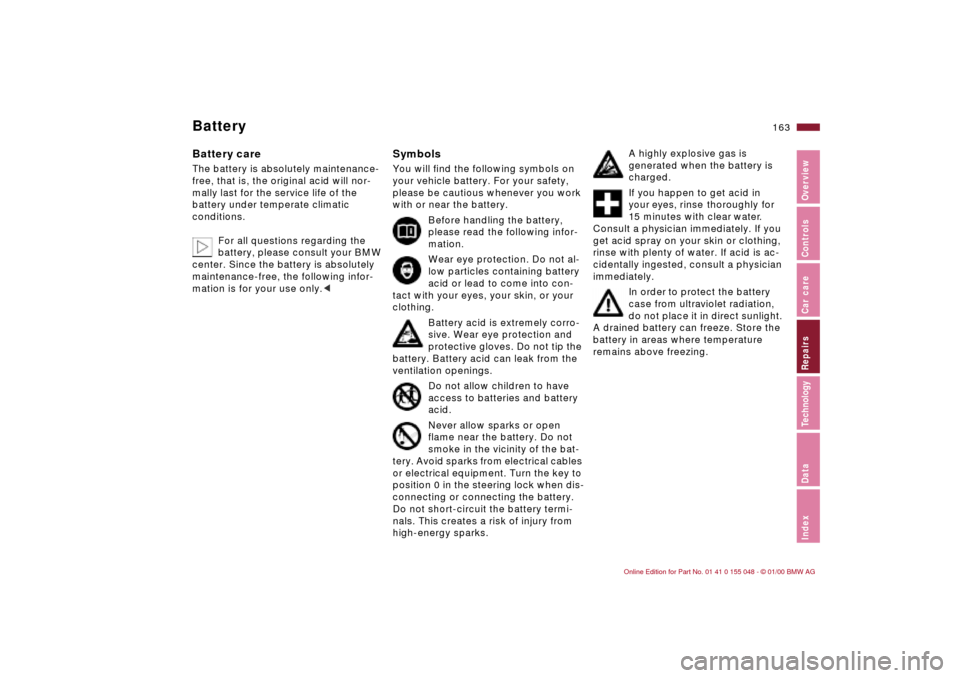
163n
IndexDataTechnologyRepairsCar careControlsOverview
BatteryBattery careThe battery is absolutely maintenance-
free, that is, the original acid will nor-
mally last for the service life of the
battery under temperate climatic
conditions.
For all questions regarding the
battery, please consult your BMW
center. Since the battery is absolutely
maintenance-free, the following infor-
mation is for your use only.<
SymbolsYou will find the following symbols on
your vehicle battery. For your safety,
please be cautious whenever you work
with or near the battery.
Before handling the battery,
please read the following infor-
mation.
Wear eye protection. Do not al-
low particles containing battery
acid or lead to come into con-
tact with your eyes, your skin, or your
clothing.
Battery acid is extremely corro-
sive. Wear eye protection and
protective gloves. Do not tip the
battery. Battery acid can leak from the
ventilation openings.
Do not allow children to have
access to batteries and battery
acid.
Never allow sparks or open
flame near the battery. Do not
smoke in the vicinity of the bat-
tery. Avoid sparks from electrical cables
or electrical equipment. Turn the key to
position 0 in the steering lock when dis-
connecting or connecting the battery.
Do not short-circuit the battery termi-
nals. This creates a risk of injury from
high-energy sparks.
A highly explosive gas is
generated when the battery is
charged.
If you happen to get acid in
your eyes, rinse thoroughly for
15 minutes with clear water.
Consult a physician immediately. If you
get acid spray on your skin or clothing,
rinse with plenty of water. If acid is ac-
cidentally ingested, consult a physician
immediately.
In order to protect the battery
case from ultraviolet radiation,
do not place it in direct sunlight.
A drained battery can freeze. Store the
battery in areas where temperature
remains above freezing.
Page 164 of 199
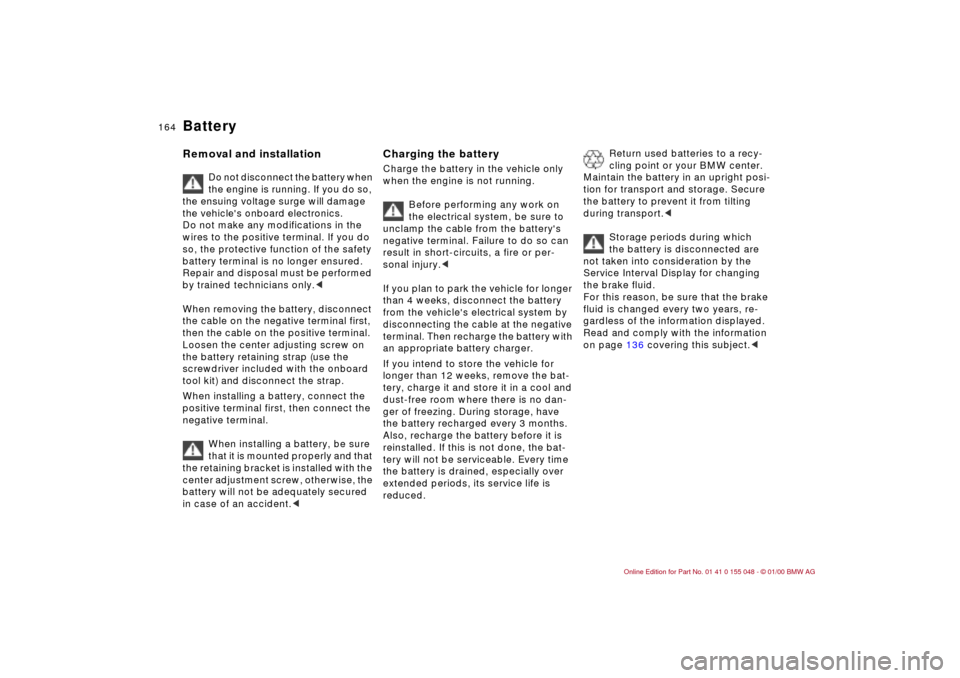
164n
BatteryRemoval and installation
Do not disconnect the battery when
the engine is running. If you do so,
the ensuing voltage surge will damage
the vehicle's onboard electronics.
Do not make any modifications in the
wires to the positive terminal. If you do
so, the protective function of the safety
battery terminal is no longer ensured.
Repair and disposal must be performed
by trained technicians only.<
When removing the battery, disconnect
the cable on the negative terminal first,
then the cable on the positive terminal.
Loosen the center adjusting screw on
the battery retaining strap (use the
screwdriver included with the onboard
tool kit) and disconnect the strap.
When installing a battery, connect the
positive terminal first, then connect the
negative terminal.
When installing a battery, be sure
that it is mounted properly and that
the retaining bracket is installed with the
center adjustment screw, otherwise, the
battery will not be adequately secured
in case of an accident.<
Charging the battery Charge the battery in the vehicle only
when the engine is not running.
Before performing any work on
the electrical system, be sure to
unclamp the cable from the battery's
negative terminal. Failure to do so can
result in short-circuits, a fire or per-
sonal injury.<
If you plan to park the vehicle for longer
than 4 weeks, disconnect the battery
from the vehicle's electrical system by
disconnecting the cable at the negative
terminal. Then recharge the battery with
an appropriate battery charger.
If you intend to store the vehicle for
longer than 12 weeks, remove the bat-
tery, charge it and store it in a cool and
dust-free room where there is no dan-
ger of freezing. During storage, have
the battery recharged every 3 months.
Also, recharge the battery before it is
reinstalled. If this is not done, the bat-
tery will not be serviceable. Every time
the battery is drained, especially over
extended periods, its service life is
reduced.
Return used batteries to a recy-
cling point or your BMW center.
Maintain the battery in an upright posi-
tion for transport and storage. Secure
the battery to prevent it from tilting
during transport.<
Storage periods during which
the battery is disconnected are
not taken into consideration by the
Service Interval Display for changing
the brake fluid.
For this reason, be sure that the brake
fluid is changed every two years, re-
gardless of the information displayed.
Read and comply with the information
on page 136 covering this subject.<
Page 171 of 199

Overview
Controls and features
Operation, care
and maintenance
Owner service procedures
Technical data
Index Advanced technology
171n
IndexDataTechnologyRepairsCar careControlsOverview
Adaptive Transmission Control
(ATC)172
Airbags173
Dynamic Stability Control
(DSC)173
Radio reception174
Safety belt tensioner174
Interior rearview mirror with
automatic dimmer175
Rain sensor176
Tire Pressure Control (RDC)177
Self-diagnostics178
Rollover protection system179
Xenon lamps179
Technology